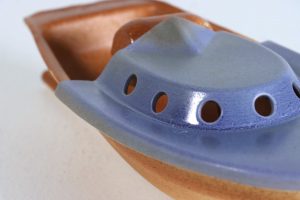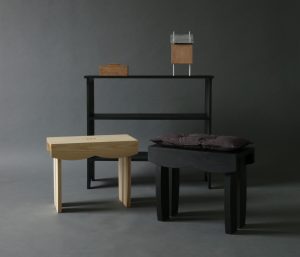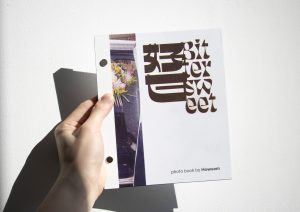Kian
Sadaf Asl Soleimani
See it On Campus: Level 2
Visitor InfoECU Award Recipient
ECU Graduation Awards for Anti-Racism and Social Justice – Design – Honourable Mention
Translating experiential knowledge through craft
Medium: Woven Cloth on TC2 Jacquard Loom, Photoshop
Role: Designer, Weaver
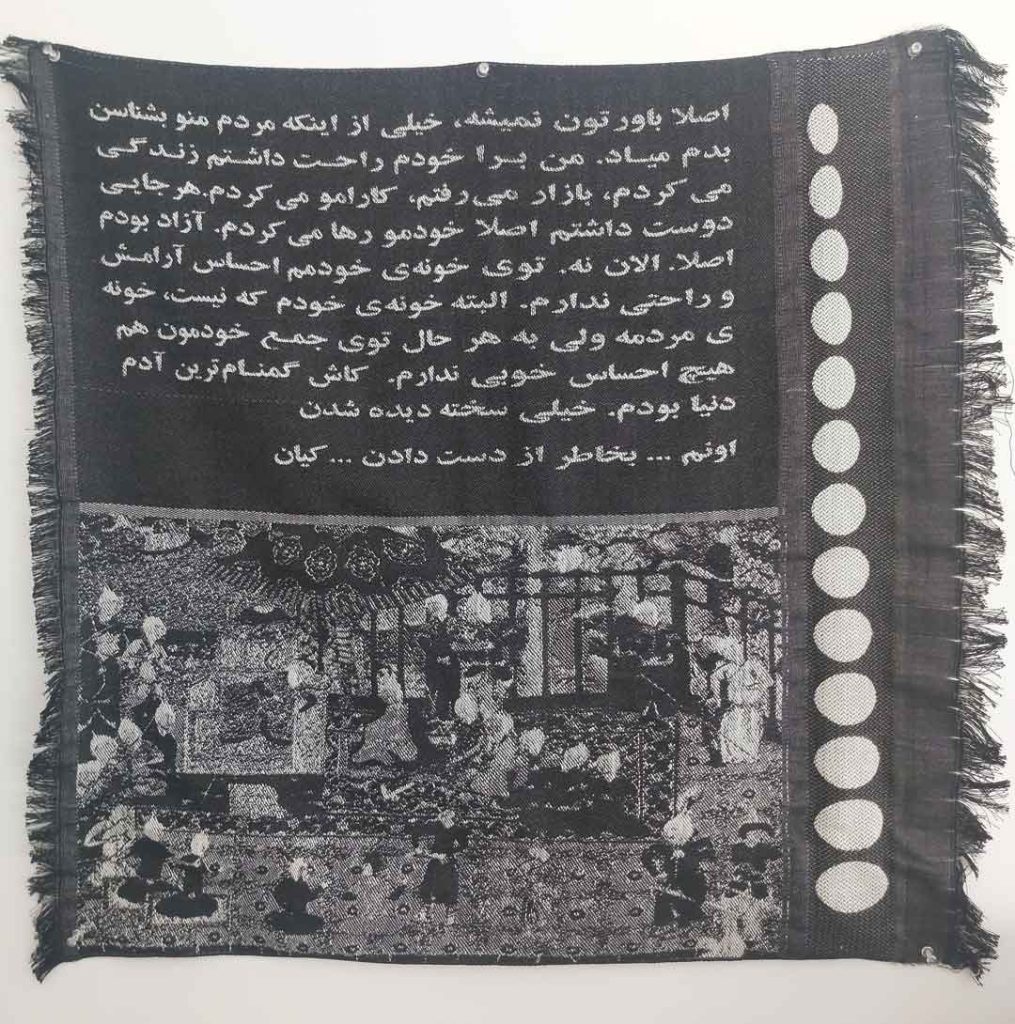
About this piece
This project serves as a multi-sensory, multi-story and even multi-reflectory piece in my research process. In this project, I tried to situate myself as an Afghan woman who is weaving to tell a story, a dyslexic student who has a hard time communicating through written language, and an Iranian girl who is constantly thinking of home.
I wanted to investigate how to communicate these experiences through a piece in a way that the experiential data can be collected from a crafted object. Therefore I learned how to weave a cloth using TC2 Jacquard Loom. Jacquard Loom being the inspiration behind modern computers, served as a medium which constantly reminded me of the women’s contributions in the digital area and how their contributions were overshadowed solely because of their identity. “Hardware . software, wetware, before their beginnings and beyond their ends. Women have been the simulators, assemblers, and programmers of the digital machines.” (Plant, 1998) Textile fabrication was the software lining for all technology as well as the first canvas for writing.(Plant, 1998) My experimental approach toward my practice combined with the importance of weaving and textile fabrication in the history of feminism, and the fact that TC2 Jacquard Loom is a loom that works with Photoshop and weaves each pixel made it evident for me to engage with this material (strings) and platform (TC2 Jacquard Loom) as the next step in my research.
The story behind
For this piece, I decided to portray the story of Kian Pirfalak and Mahmonir Molaie on the top half, and an illustration from Shahname Tahmasbi on the second half.
Kian was a 10 year old boy who was killed at the attack on Izeh market, in a shooting by the Islamic government security forces while he sat in his parents’ vehicle on 15 November 2022. (for timeline, refer to the Positionality) His mother, Mahmonir Molaie, refusing to keep his body at the morgue, took Kian home and asked neighbours for ice to keep his body cold until the funeral day. This was due to the fear of security forces stealing the child’s body, as that has happened in many cases.
Mahmonir Molaie has been the pivotal advocate for what happened to Kian that day. In this piece, I took a paragraph from her interview with IranWire (Iranwire & Ghadarkhan, 2023) and wove it using Jacquard loom. In this section of the interview, Mahmonir states:
You may not believe it, but I hate for people to know me. I was living peacefully on my own, going to the Bazar, doing my work. I was peaceful wherever I was. I was free. Now I am not. I don’t feel comfortable in my own home. Actually, it’s not my home, it’s someone else’s but I don’t feel good overall. I wish I was the most unknown person in this world. It’s so hard to be seen.
Especially because … we lost… Kian
In this interview, Mahmonir also tells how Kian loved reading the stories of Shahname, and how she didn’t get to tell him the story of Zahhak. In Iranian culture, Shahname or “The Book of Kings” serves as a pivotal poetry book that resurrected the Persian Language in 1010 CE written by Ferdausi.
The second half of this piece, is an illustration from Shahname Tahmasbi. The Shahnama of Shah Tahmasp (r. 76–1524), also known as the Shahnama-yi Shahi, is arguably the most luxuriously illustrated copy of Firdausi’s epic ever produced in the history of Persian painting. The artistic importance of this manuscript cannot be overestimated. It is considered one of the highest achievements in the arts of the book for its superb calligraphy, painting, and illumination. (Leoni, 2008) It is the high point of Persian miniature painting and contains 258 illustrated paintings.
Kava Tears Up Zahhak’s Letter, folio 31v from the Shah Tahmasp Shahnama (between 1522-1535, Tabriz), attributed to Qadimi, Tehran Museum of Contemporary Art, Reproduced in Shahnamayi Shah Tahmasp, Tehran Museum of Contemporary Art, 2021, 34/303. Photographed by Mohsen Mohamadkhani for Tehran Museum of Contemporary Art.
This piece, which is said to be illustrated by Ghadimi under the supervision of Sultan Muhammad, is the portrait of the scene in which Kaveh tears the agreement sent by King Zahhak. In Shahnameh, Zahhak is the notorious king who has two snakes on his shoulder and in order to prevent those snakes from attacking him, he feeds the brains of the young men to these snakes. Kaveh, who has lost 17 of his sons to these snakes is going to retaliate against Zahhak, is the symbol of a parent who will sacrifice everything to avenge his children’s death in Iranian folk culture. Zahhak, on the other hand, is the symbol of a king that kills his own people in order to prevent the snakes on his shoulder from eating his own brain.
Process
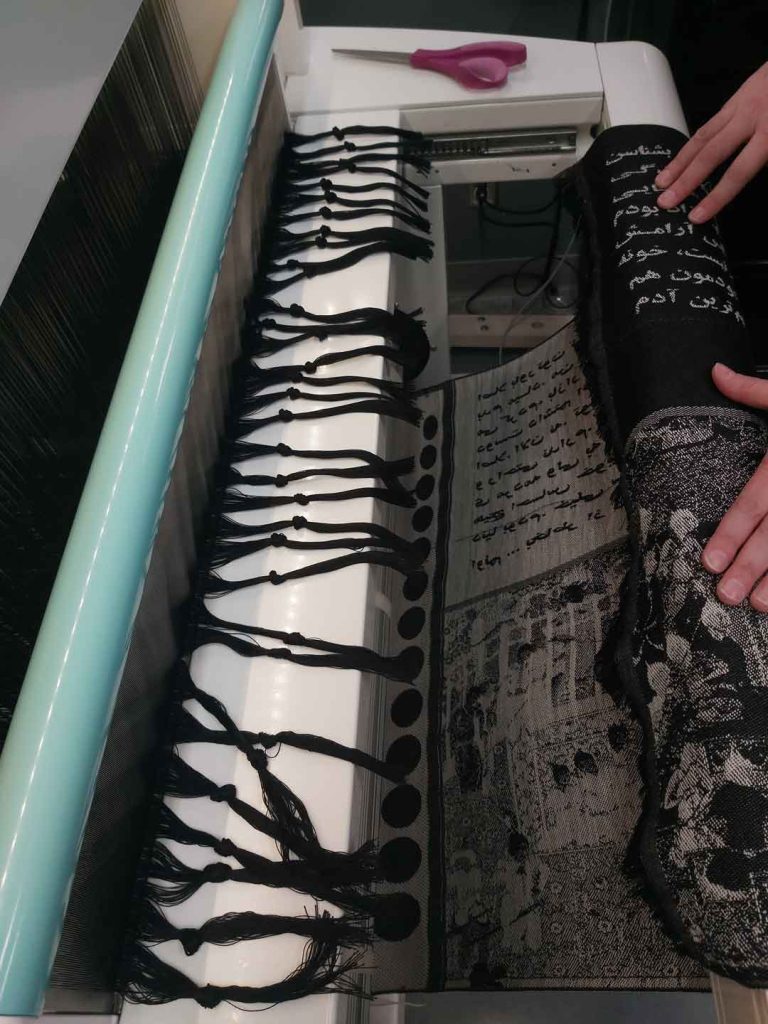
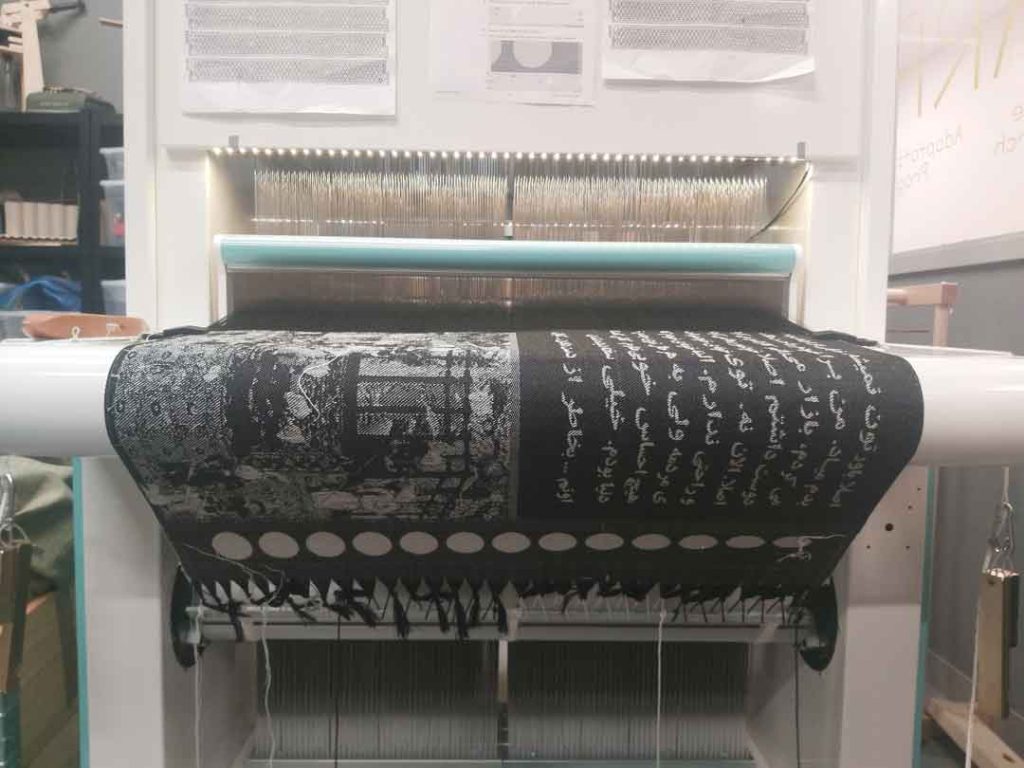
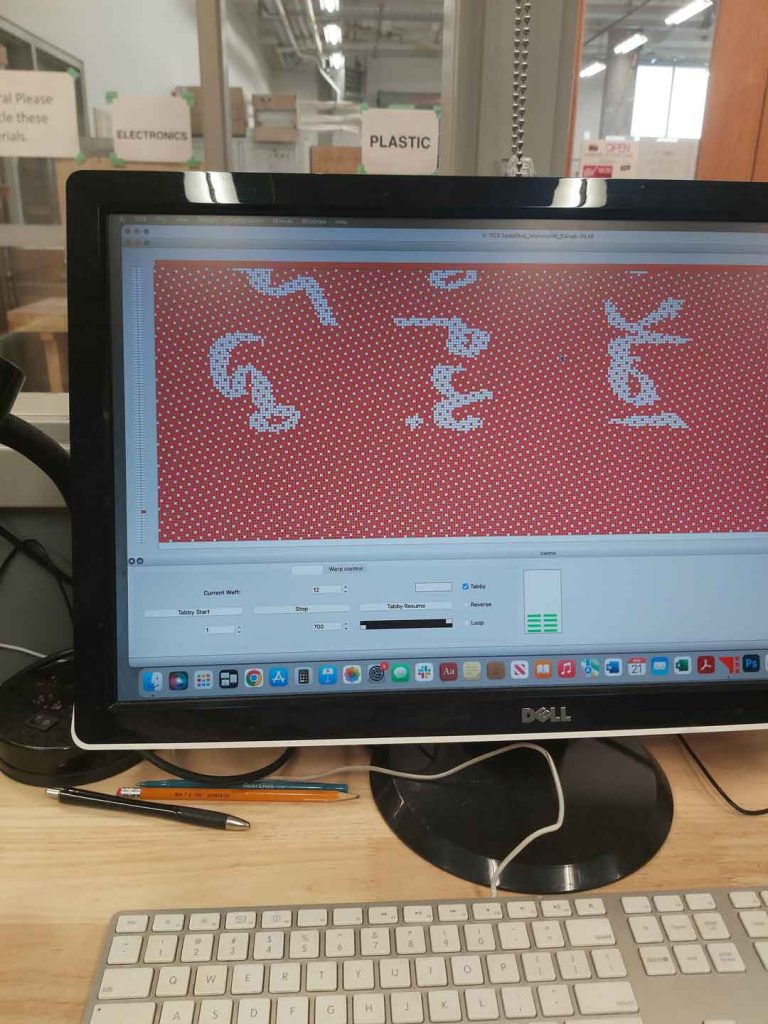
Pixels are deformed when in direct contact with the user. “The way of hand is personal, contextual, indescribable. Little can surpass the hands in showing that we know more than we can say.” (Mccullough, 1998) While weaving this piece, I was in constant awareness of my body movement as well as being lost and unfocused about my surroundings. The first section that I wove was the circles on the right side of the piece. They are the indication of my strength and pressure that has deformed the perfect initial circle on the bottom right. By weaving these circles, I was able to determine how much deformation my designed piece needed in Photoshop. Therefore I had to re-adjust my initial design by 30 percent to achieve perfect squares of pixel on my final piece.
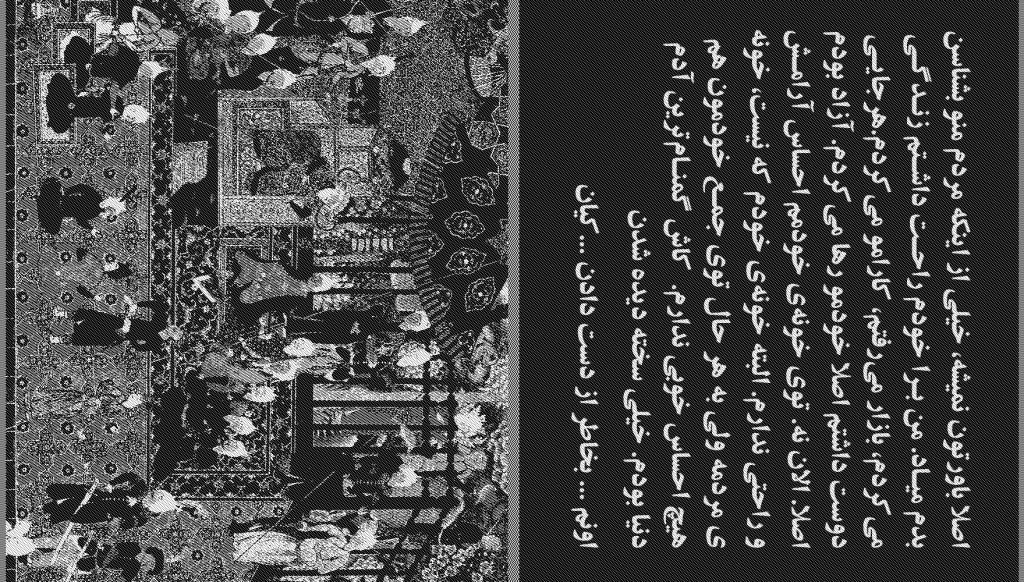
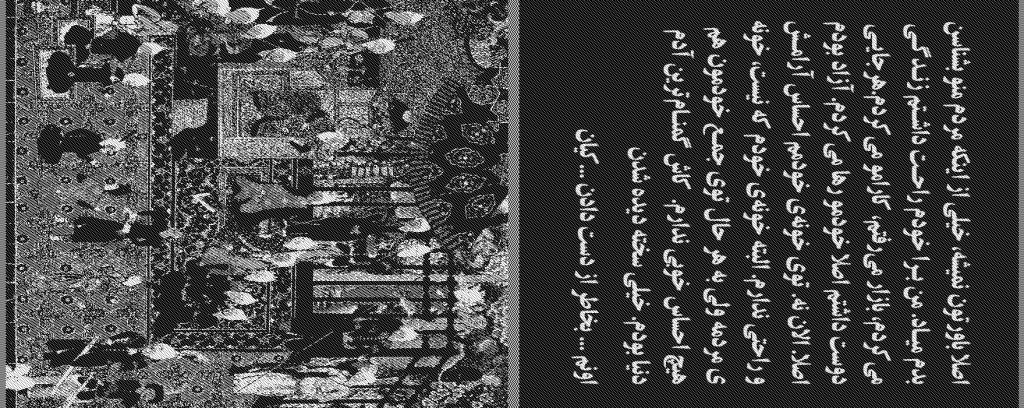
Although I was aware that my body was constantly moving to weave 700 lines of pixelated data, I also noticed that the pain and pressure that I used to feel that morning was slowly disappearing. In those moments I understood why Afghan women seek sanctuary in the act of weaving. I could understand McCullough’s notion on how “Hands are the best source of tacit personal knowledge because of all extensions of the body, they are the most subtle, the most sensitive, the most probing, the most differentiated, and the most closely connected to the mind.” (Mccullough, 1998)
My only regret is that I am not (yet) able to share my heartbeat, my body temperature, and my movement … through this piece with Mahmonir. I wish there was a way for me to tell her that my body physically reacts whenever I think of Kian. I wish she could see my anger and feel the pressure I put on the loom when weaving the face of Zahhak. This piece may look like an upside Instagram post (with the caption on top and picture down below) but it is my way of showing Mahmonir that although I never met Kian, I am mourning his death every day.
References
Leoni, F. (2008). The Shahnama of Shah Tahmasp. Metmuseum.org. https://www.metmuseum.org/toah/hd/shnm/hd_shnm.htm
Mccullough, M. (1998). Abstracting craft : the practiced digital hand. Mit Press.
Plant, S. (1998). Zeros and ones : digital women and the new technoculture. London Fourth Estate.
